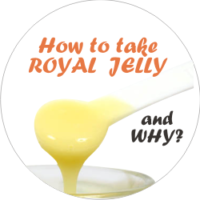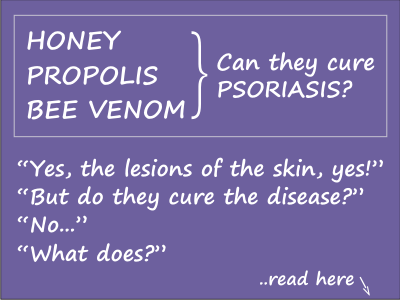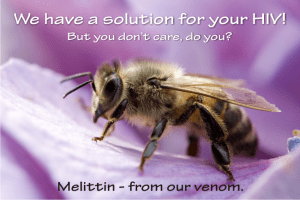Bee venom therapy, aka bee sting therapy, is best known for the treatment of arthritis and other rheumatoid conditions.
People also call it apipuncture or or bee venom acupuncture. Not to be confused with apitherapy, because they are not the same.
Apipuncture is a therapy that uses bee stings or punctures with bee venom and apitherapy uses all the products of the hive in the treatment of various conditions.
What is bee sting therapy and how did it start?
Arthritis is most surely the oldest disease in humanity. In ancient times, Homo sapiens probably noticed that he got some relief after being stung by the bees, making bee stinging the first apitherapy received by humans.
The Austrian physician Philip Terc is considered to be the father of modern apitherapy. He published his research in “Report about a Peculiar Connection between the Bee Stings and Rheumatism” in 1888.
– In the US, bee venom apitherapy was introduced after the First World War by Bodog Beck, who published a book in 1935 about using bee venom against rheumatoid arthritis. Then a student of Beck’s, Charles Marz, popularized bee venom therapy in the USA. He was known by many as the “King of Bee Venom Therapy.”.
He had been practicing apitherapy for over 60 years with remarkable results, and most of his experience had been with treating arthritis, but his success was with multiple sclerosis as well.
– In Europe, the first commercial bee venom preparation was released in 1928.
How is bee sting treatment done?
Doctor Philip Terc himself had rheumatism and cured himself with bee stings. He thought that the stronger the rheumatism form, the stronger the bee venom doses should be.
He distinguishes three phases of healing:
1. In the first phase, the patient develops a pathological immunity with very weak reaction to bee stinging.
2. In the second, he is as sensitive to bee venom as normal people, with the development of a local painful reaction. In this phase, healing begins.
3. In the third phase, healing is completed.
Terc treats his patients with 1 to 50 bees per session. From his 660 patients, 544 recovered completely, 99 improved and 17 did not recover at all.
In 1935, Bodock Beck described modern BV therapy mostly against arthritis in his pioneering book “Bee Venom Therapy”. Dr. Beck was an internal medicine physician from Hungary who had a thriving practice in New York City for many years. His clientele included people from all walks of life, who had various rheumatic conditions. His specialty was treating rheumatoid arthritis, but he discovered that virtually any inflammatory condition would respond to bee venom therapy.
The book is now out-of-print, but with the help of Harold Goodman, it was reprinted in 1997 and is now available for sale on Amazon: The Bible of Bee Venom Therapy: Bee Venom, Its Nature, and Its Effect on Arthritic and Rheumatoid Conditions.
The book is indeed the bible of the profession and will teach you what you need to know to understand why bee venom therapy works and how you can use it therapeutically.
An extensive Russian monograph by professor V.N. Krylov, Pcelni yad (Bee venom in Russian), from 1995, and a 2012 review by Mahmoud Abdu Al-Samie Mohamed Ali, from the Department of Plant Protection, Faculty of Agriculture, Ain Shams University, Cairo, Egypt, “Studies on Bee Venom and Its Medical Uses” gather much information on the medical applications of bee venom.
Apitherapy has developed a lot for the last 10 years, developing as a new technique for treating arthritis, which is now used most of all in South Korea.
Bee venom therapy for rheumatoid arthritis
What is arthritis?
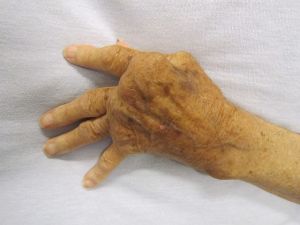
picture courtesy wikimedia commons
There are 2 types of arthritis. Rheumatoid Arthritis or Polyarthritis (RA) and Osteoarthritis (OA).
1. Rheumatoid Arthritis is a chronic, systemic, inflammatory disorder that may affect many tissues and organs, but principally attacks the joints, ending with the destruction of the articular cartilage and ankylosis of the joints (ankylosis = stiffness of a joint due to abnormal adhesion and rigidity of the bones of the joint, which may be the result of injury or disease, after wikipedia).
Almost 1% of the world’s population is afflicted by rheumatoid arthritis, three times more often in women than in men.

picture courtesy wikimedia commons
2. Osteoarthritis is the most common form of arthritis, in which joints wear out. Also known as degenerative arthritis, degenerative joint disease, or osteoarthrosis.
Symptoms: joint pain, tenderness, stiffness, locking, and sometimes an effusion.
Causes: hereditary, developmental, metabolic, and mechanical deficits.
When bone surfaces become less well protected by cartilage, bone may be exposed and damaged. It follows a decreased movement secondary to pain, regional muscles may atrophy, and ligaments may become more lax.
The pain is often described as a toothache type pain. Osteoarthritis is the leading cause of chronic disability in the United States, affecting nearly 27 million people.
In Australia, it affects about 1.9 million people, and about 8 million people in the United Kingdom.
How can bee sting therapy help in arthritis?
According to scientist Stefan Bogdanov, who worked for 26 years at the Swiss Bee Research, the mechanism of action of bee venom in treating arthritis is clarified:
· bee venom blocks the building of the pro inflammarory substances cytokinine, PGE-2, NO, Tumor Necrosis
Factor TNF-2 and Enzyme COX-2
· bee venom inhibits the proliferation of rheumatoid synovial cells.
Bee venom does not seem to influence rheumatoid deformation, as shown by patient’s X-rays, but it does control pain and inflammation. The success rates are generally good, lying generally between 60 and 90 %.
Tested on arthritic rats, bee venom treatment was as effective as cortisol treatment.
From Dr. Ludyansky’s vast experience in Russian hospitals and general practitioners, as well as his own experience in treating arthritis, bee venom apipuncture is better against rheumatoid arthritis than against osteoarthritis.
What kind of bee venom treatment can we do?
There are 5 different bee venom treatments that can be done: bee stings (BS), apipuncture (AP), injections, electrophoresis and phonophoresis (application with ultrasound waves).
Lee et al. examined the use of apipuncture in muskoskeletal pain. Bee venom was used in the treatment of different pain conditions: neck pain, low back pain, herniated lumbar pain, disc pain, shoulder pain after stroke, acute ankle sprain, wrist sprain, rheumatoid arthritis and knee osteoarthritis.
Bee stings, aka apipuncture therapy, was useful in all these conditions. Apipuncture relieves pain more effectively than acupuncture. There is need for more studies on the effects of bee venom stinging in acupuncture points as compared to stinging in other body points. Today only stinging in acupuncture points is used in treatment.
Are thre studies that support bee sting treatment?
There are experimental studies and clinical trials of apipuncture for arthritis in the databases of PUBMED, EMBASE and the Cochrane Library. There are over 1700 scientific publications on the composition and various effects of bee venom in animals and humans that have been published by now.
Almost all recent studies are conducted in South Korea, two leading Korean journals, “The Journal of Korean Society for Acupuncture and Moxibustion” and “The Journal of Korean Oriental Medicine” are publishing the studies. Many of them are open to public and we can find them published in scientific pages, like ncbi.nlm.nih.gov. Here are some of them:
• In 2004, the study “Acupoint stimulation with diluted bee venom (apipuncture) alleviates thermal hyperalgesia in a rodent neuropathic pain model: involvement of spinal alpha 2-adrenoceptors.” was conducteed by Roh DH et al, from the Department of Veterinary Physiology, College of Veterinary Medicine, Seoul National University, South Korea. The study was published by ncbi.nlm.nih.gov. It investigated the potential antihyperalgesic and antiallodynic effects of apipuncture in a rat neuropathic pain model.
Their conclusion was:
“The relieving effect of apipuncture on thermal hyperalgesia was found to be mediated by spinal alpha2-adrenoceptors, but not opioid receptors. These data suggest that apipuncture might be an effective alternative therapy for patients with painful peripheral neuropathy, especially for those who are poorly responsive to opioid analgesics.”
• In 2006, Baek YH et al, from South Korea studied “Antinociceptive effect and the mechanism of bee venom acupuncture (Apipuncture) on inflammatory pain in the rat model of collagen-induced arthritis: Mediation by alpha2-Adrenoceptors.” The results showed that bee venom apipuncture can relieve inflammatory pain in collagen-induced arthritis rats and the antinociceptive effect of bee venom acupuncture can be mediated by alpha2-adrenergic receptor. See the entire article here.
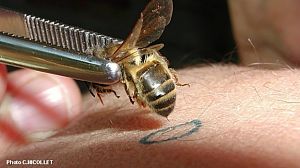
• In 2010, ncbi.nlm.nih.gov published the study “Apipuncture treatment for central post-stroke pain”, conducted by Yun SP, Sun BC, from aint Paul’s Oriental Medical Center, Seoul, Korea, assessed the effectiveness of apipuncture treatment for central post-stroke pain. The results showed that apipuncture was an effective and safe intervention to treat central post-stroke pain.
How is apipuncture done?
Bee venom acupuncture or apipuncture, is a kind of herbal acupuncture, that exerts not only pharmacological actions from the bioactive compounds isolated from bee venom, but also a mechanical function from acupuncture stimulation.
Here is a demonstration of apipuncture session:
Is bee venom therapy better than hormone therapy against rheumatic pain?
There are many researchers who attribute the success of bee venom therapy to the activation of the main hormone systems of the body: the thyroid, pituitary gland, hypothalamus, and adrenal gland.
Hormone therapy, for example, cortisone and ACTH hormones, are also used for rheumatic pain.
But with time, hormone therapy leads to bad side effects, like a reduction in the activity of the hormonal glands, while bee venom constantly activates their activity. Isolated from venom, melittin also has toxic side effects, as do some of the other individual compounds in venom. But when whole venom is applied, no side-effects have been shown, other than in allergic patients.
Why isn’t apipuncture widely used for therapy?
Here is an answer: “There is limited evidence demonstrating the efficacy of apipuncture in arthritis. Rigorous trials with large sample size and adequate design are needed to define the role of BVA for these indications. In addition, studies on the optimal dosage and concentration of BVA are recommended for future trials.”
Other people, like Harold Goodman, a physician who has been using bee venom for 23 years with patients who otherwise were not being helped, have a different opinion. Also, his experience proved great results in using apipuncture even in multiple sclerosis and sarcoidosis, he failed to collaborate with the sarcoid society, the multiple sclerosis society, or George Washington University.
He says they were wrongly using bee venom, because it had been adulterated and rendered virtually dead, which finally led to no results of the treatment.
In his opinion, the pharmaceutical industry, which makes millions each year in the US alone producing anti-inflammatory medications, have simply no interest in bee venom, since it is a natural substance which can’t be patented.
You can read his entire opinion in the review he made on the book The Bible of Bee Venom Therapy: Bee Venom, Its Nature, and Its Effect on Arthritic and Rheumatoid Conditions.
Recently, after long efforts by the American Apitherapy Society and its members, some interest has been shown by national institutions in several Western European countries and the USA for clinical and large scale tests of bee venom therapy.
But no matter what difficulties science encounters in producing a new drug, or a new remedy, eventually we will learn how to benefit from nature, and find a better way. Alternative medicine is gaining an important role in our lives, day by day.
If you want to try apipuncture, first find where you can find registered apitherapy practitioners in your area. Here is a list of such places all over the world. You definitely can find some close to you. If not, well, you’ll just have to travel to South Korea for your stings! 🙂
Related articles:
• Bee venom
• Bee venom for therapy: General Information
• Bee venom for therapy: Alzheimer’s disease
• Bee venom for therapy: Multiple Sclerosis
• Bee venom for therapy: Homeopathic Remedies
• Bee venom a possible natural treatment for Parkinson’s disease
• Honey and Alzheimer’s natural treatment
• What is the best cream for wrinkles?
• How to treat bee sting
• Venom Immunotherapy or HOW TO TREAT BEE STING ALLERGY FOR GOOD!
*********
References:
– BECK, B F (1935) Bee venom therapy. D. Appleton-Century Company New York and London
– KRYLOV, V (1995) Pcelni yad (Bee venom in Russian). Nizhny Novgorod University Nizhny Novgorod; 221
– ALI, M (2012) Studies on Bee Venom and Its Medical Uses. IJART 1
– http://en.wikipedia.org/wiki/Osteoarthritis
– Stefan Bogdanov, Bee Venom: Composition, Health, Medicine: A Review, bee-hexagon.net;
– Lee JD et al, An Overview of Bee Venom Acupuncture in the Treatment of Arthritis, (2005)
Picture sources:
– “Rheumatoid Arthritis” by James Heilman, MD – Own work. Licensed under CC BY-SA 3.0 via Wikimedia Commons
– “Gonarthrose-Knorpelaufbrauch”. Licensed under CC BY-SA 3.0 via Wikimedia Commons;
– “Senior Couple Using The Mobile Phone Stock Photo” picture by Witthaya Phonsawat via Free Digital Photos



